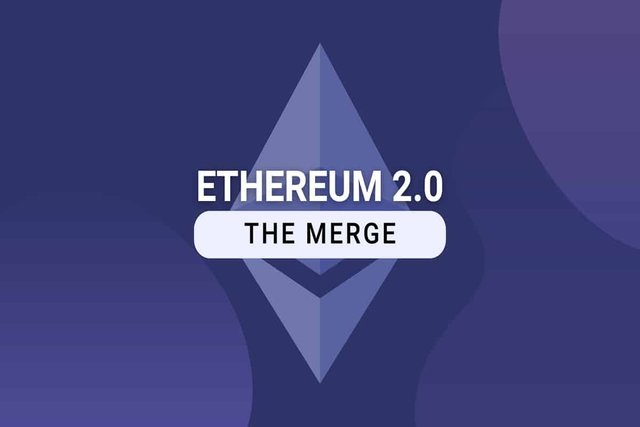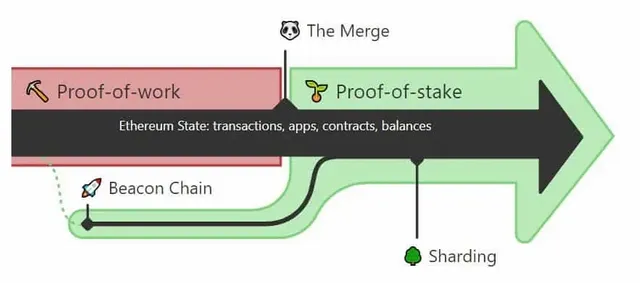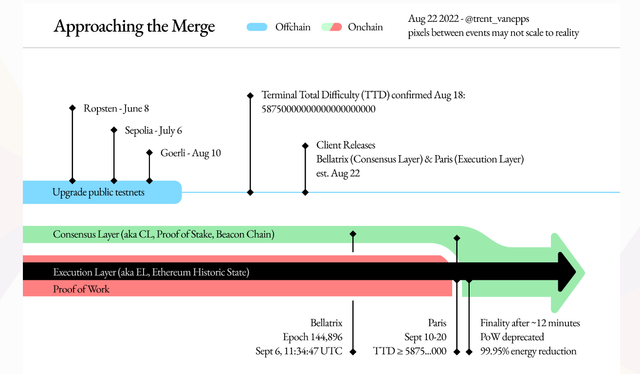The Merge: Ethereum 2.0
Hello everyone, on my first learning episode today, I want to talk about the recent Ethereum Blockchain merge; its meaning, possible benefits, and its implication for the current state of the Ethereum ecosystem.
Join me on this study ride!

The Merge (Ethereum 2.0)
The Ethereum blockchain as we all know is the second largest blockchain ecosystem after the Bitcoin blockchain and likely the biggest smart contract-based blockchain, launched in 2014 by Vitalik Buteri, the blockchain has seen the growth of decentralized finance (DeFi) to new heights which include the adoption of web3.
The Ethereum blockchain for years used the proof-of-work (PoW) consensus algorithm in its Ethereum Virtual Machine (EVM), which was proved to be efficient in energy consumption.
What is a consensus algorithm you may ask?
A consensus algorithm is a section of blockchain technology that oversees the consensus mechanism, the mechanism is simply described as a potent way of coming to a unified agreement to ensure that the most recent data on the chain is accurate and legitimate by every means necessary.
The PoW consensus requires miners to solve complex computation problems before a block of transactions can be validated. This required the use of high-powered computers that were energy-consuming and cost-ineffective. For this reason, the blockchain opted for a cost-effective consensus layer, hence, The Merge.
What is the Merge?
In simple terms, the Ethereum merge is the combination of the present EVM consensus algorithm state with an improved consensus algorithm with the sole purpose of enhancing the blockchain performance, which In this case is the Proof of Stake (PoS) consensus algorithm. The PoS work by staking. Validator nodes are required to stake ETH on the blockchain which serves as collateral and part of the blockchain value asset.
The Ethereum merge happened on the 15th of September 2022, this saw the new consensus mechanism called Beacon Chain get connected to the current Ethereum virtual machine.

The transition was divided into two major steps rather than just a one-step transition. The first step was initiated in December of 2020 with the launch of the Beacon chain, which underwent a series of testing by stakers, and allowed developers to fix bugs.

As seen above, there were a series of off-chain testing (Testnet) and on-chain testing before the merge. The second step was the merge, which recently occurred. this step saw the consensus layer of the beacon chain (PoS) merge with the current EVM state of the traditional PoW chain.
Benefits?
The merge crucial benefit is the extensive reduction of energy consumption. As reported, The founder of Ethereum Vitalik Buteri said the merger has the potential to cut down global energy consumption by 0.2% which is arguably the biggest carbon emission reduction in human history. This does not only make Ethereum Blockchain more eco-friendly, but it could also attract new investments from Clean-energy environment cooperations like the ESG-based Investors.
Reference Article
Another benefit of the Ethereum merge is the improved security. the previous consensus algorithm required computational power to become a validator note. this implies that nodes with huge processing power controlled most of the blockchain network. But with the recent merge would require ownership of about 51% of the staked ETH assets to control the majority of the network. This ensures that the network stays decentralized, hence preventing a 51% attack on the blockchain.
Implications?
I will answer this by telling you what the merge would not do to the current Ethereum ecosystem. Some of these implications include the following:
1- Faster Transaction
No! The merge does not imply that the transaction processing speed would increase. As a matter of fact, the transaction speed would remain the same. This could change as the blockchain is looking to improve its network scalability.
2- Reduce Gas Fee
No! the merge does not guarantee a reduction in the cost of transaction as only the mechanism was improved but not the network capacity. thus throughput ratio remains the same.
3- Withdrawal of Staked ETH
Post merge, the staked ETH will only be available for withdrawal after another network upgrade.
Conclusion
The ability of the cryptocurrency industry to adapt in a way that prioritizes our planetary well-being would send a strong message to regulators if the switch to PoS is successful. This would ensure a sustainable solution to the carbon emission problem and a possible reduction in probing and sanctions of cryptocurrency. Ideally, The Ethereum Merge will probably spark additional research and cooperation between the cryptocurrency industry and Congress as we take into account the White House Office of Science and Technology Policy's (OSTP) report on Climate and Energy Implications of Crypto-Assets in the United States.
Thanks for reading!